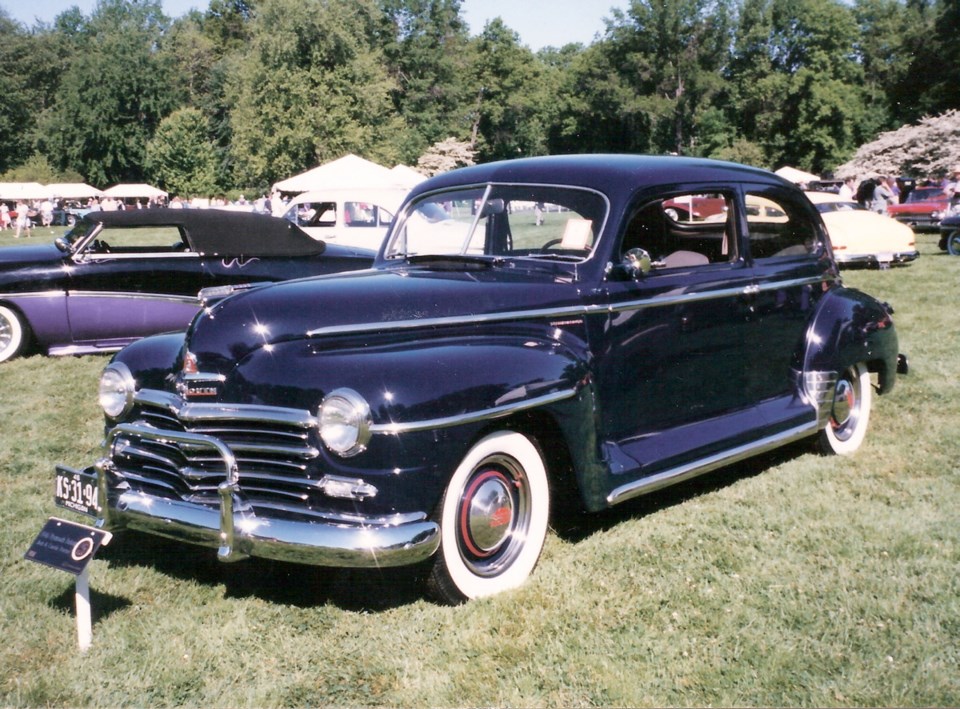This column usually features a significant vehicle, automobile development or maybe an important personality from automotive history. Today, we are remembering a vehicle that was about as middle-of-the-road and bread-and-butter as they come. In fact, it is still remembered as just “a real nice car.”
This was the 1946-1948 Plymouth that was also built into early 1949 until the new ’49s were ready. As with others after the Second World War, Chrysler aimed to satisfy the pent-up demand for new cars as quickly as possible by offering essentially pre-war designs.
There were some changes to the ’46 Plymouth, such as a new grille and revised bumpers and rear fenders, but it was basically a 1942 model.
Walter Chrysler had introduced the Plymouth in 1928 by revising a Chrysler model. It was their competitor in the low-priced field, and it came at a a very opportune time. The advent of the 1930s Depression brought on by the stock-market crash might well have claimed Chrysler Corp. without the low-priced Plymouth.
By 1931, Plymouth had climbed to third in sales behind Chevrolet and Ford, firmly establishing Chrysler Corp., along with General Motors and Ford Motor Co., as a member of the Big Three.
When production returned in 1945, the Plymouth seemed just a little more luxurious than the Ford or Chevrolet. Perhaps it was the smoother ride provided by the 2,972-millimetre wheelbase, compared with Chevrolet’s 2,946 and Ford’s 2,896 mm. Or maybe it was the quiet, reliable side-valve six that traced its heritage back to 1933.
The Plymouth was named after Plymouth, Massachusetts, landfall for the Pilgrims’ arrival in the new world in 1620. Its emblem was the sturdy Mayflower that carried those brave souls to America, and a laid-back version served as the Plymouth’s hood ornament. Its badge contained a framed picture of the ship.
The emblem was appropriate because the Plymouth always seemed to project an image of sturdy, no-nonsense dependability, something like a good pair of black oxford shoes.
Compared with today’s engine proliferation, once they broke out of the four-cylinder mode, Ford, Chevrolet and Plymouth went to three different engine types and stayed with them for many years.
Ford had its side-valve V-8 introduced in 1932 in response to Chevy’s overhead-valve inline six, which had offered “just a little more” in 1929. Plymouth was the last of the three to leave the four-cylinder club, but when it did in 1933, its entry was a side-valve six.
Like rivals Chevrolet and Ford, the ’46 Plymouth had a three-speed manual transmission with the shift lever on the steering column, although it didn’t have vacuum-assisted shifting as Chevy did.
When originally introduced in 1933, the Plymouth six displaced 3.1 litres (189.8 cu. in.) and developed 70 horsepower. By the time the 1946 model arrived, it was up to 3.6 litres (217.8 cu. in.) and 95 horsepower.
Although Ford had always been considered the hot number in competition, Plymouth turned in a few surprising performances. In the famous 1935 Monte Carlo Rally, a 1934 Plymouth placed second in the large-car division driven by two women, Misses Darre Brandt and Irma Christiansen. A 1934 Plymouth also won the 644-kilometre Durban to Johannesburg endurance race in South Africa, setting a world record in the process.
After the Second World War, stock-car racers such as Johnny Mantz and Lee Petty (father of “King Richard,” grandfather of the late Kyle) proved that there was still life in the old flat-head six by occasionally beating such hotdogs as Oldsmobile Rocket 88s and Hudson Hornets.
It didn’t happen by stunning speed, but due to the simple virtue of reliability. While the fast cars burned themselves up competing for the lead, the Plymouth just stroked along, waiting for them to blow each other off, proving the old racing adage that you have to finish to win.
Tire-burning speed was not what those early postwar Plymouths were about. In a test by Tom McCahill of Mechanix Illustrated magazine on a 1949 Plymouth Suburban, which wouldn’t be much different from the sedan, he reported a top speed average of 135 to 137 km/h and a zero to 100 km/h time of 24.6 seconds.
Those Plymouths came in just two series, the Deluxe (meaning standard) and the Special Deluxe (meaning deluxe). There weren’t great differences, and we now find it quaint that the Special Deluxe buyer got such conveniences as two windshield wipers, two sun visors instead of one, and even a locking glove box.
Those 1946 to early ’49 Plymouths provided solid, reliable transportation and are fondly remembered by many as just “a real nice car” — not a bad epitaph for that now-departed marque.



